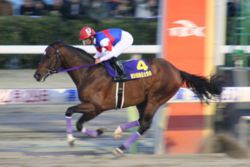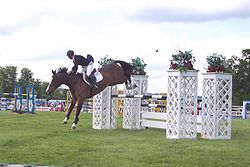
Center of balance (horse)
Encyclopedia


Equestrianism
Equestrianism more often known as riding, horseback riding or horse riding refers to the skill of riding, driving, or vaulting with horses...
, the center of balance of a horse
Horse
The horse is one of two extant subspecies of Equus ferus, or the wild horse. It is a single-hooved mammal belonging to the taxonomic family Equidae. The horse has evolved over the past 45 to 55 million years from a small multi-toed creature into the large, single-toed animal of today...
is a position on the horse's back
Back (horse)
The back describes the area of horse anatomy where the saddle goes, and in popular usage extends to include the loin or lumbar region behind the thoracic vertebrae that also is crucial to a horse's weight-carrying ability. These two sections of the vertebral column beginning at the withers, the...
which correlates closely to the center of gravity
Center of gravity
In physics, a center of gravity of a material body is a point that may be used for a summary description of gravitational interactions. In a uniform gravitational field, the center of mass serves as the center of gravity...
of the horse itself. The term may also refer to the horse's center of gravity.
For the best performance by the horse, as well as for better balance of the rider, the rider must be positioned over the center of balance of the horse. The location of the horse's center of balance depends on a combination of speed and degree of collection
Collection (horse)
Collection is when a horse carries more weight on his hindlegs than his front legs. The horse draws the body in upon itself so that it becomes like a giant spring whose stored energy can be reclaimed for fighting or running from a predator...
. For a standing or quietly walking horse, it is slightly behind the heart girth
Horse anatomy
Equine anatomy refers to the gross and microscopic anatomy of horses and other equids, including donkeys, and zebras. While all anatomical features of equids are described in the same terms as for other animals by the International Committee on Veterinary Gross Anatomical Nomenclature in the book...
and below the withers
Withers
The withers is the ridge between the shoulder blades of a four-legged animal. In many species it is the tallest point of the body, and in horses and dogs it is the standard place to measure the animal's height .-Horses:The withers in horses are formed by the dorsal spinal processes of roughly the...
. If a horse is moving at a trot
Trot (horse gait)
The trot is a two-beat diagonal gait of the horse, where the diagonal pairs of legs move forward at the same time. There is a moment of suspension between each beat....
or canter
Canter
The canter is a controlled, three-beat gait performed by a horse. It is a natural gait possessed by all horses, faster than most horses' trot but slower than the gallop, and is used by all riders. The speed of the canter varies between 16-27 km/h , depending on the length of the stride of the horse...
, the center of balance shifts slightly forward, and it moves even more forward when the horse is galloping
Horse gait
Horse gaits are the various ways in which a horse can move, either naturally or as a result of specialized training by humans.-Classification:...
or jumping
Jumping (horse)
Jumping plays a major role in many equestrian sports, such as show jumping, fox hunting, steeplechasing, and eventing. The biomechanics of jumping, the influence of the rider, and the heritability of jumping prowess have all been the focus of research....
. If a horse is highly collected, the center of balance will be farther back, regardless of gait
Horse gait
Horse gaits are the various ways in which a horse can move, either naturally or as a result of specialized training by humans.-Classification:...
, than if the horse is in an extended frame. For movements such as a rein back or the levade, the center of balance of horse and rider may be further back than at a standstill, due to the shift of weight and balance to the hindquarters of the horse
Accordingly, a saddle
Saddle
A saddle is a supportive structure for a rider or other load, fastened to an animal's back by a girth. The most common type is the equestrian saddle designed for a horse, but specialized saddles have been created for camels and other creatures...
designed for a specific discipline will attempt to place a rider naturally at the most suitable position for the anticipated activity of the horse. For example, a "close contact" style of English saddle
English saddle
English saddles are used to ride horses in English riding disciplines throughout the world. The discipline is not limited to England or English-speaking countries. This style of saddle is used in all of the Olympic and FEI equestrian disciplines, except for the newly-approved FEI events of...
, designed for show jumping
Show jumping
Show jumping, also known as "stadium jumping," "open jumping," or "jumpers," is a member of a family of English riding equestrian events that also includes dressage, eventing, hunters, and equitation. Jumping classes commonly are seen at horse shows throughout the world, including the Olympics...
, places the rider's seat farther forward than does a dressage
Dressage
Dressage is a competitive equestrian sport, defined by the International Equestrian Federation as "the highest expression of horse training." Competitions are held at all levels from amateur to the World Equestrian Games...
style English saddle.

